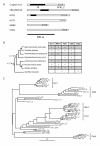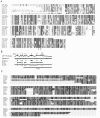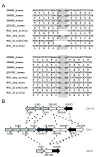Crypton transposons: identification of new diverse families and ancient domestication events
- PMID: 22011512
- PMCID: PMC3212892
- DOI: 10.1186/1759-8753-2-12
Crypton transposons: identification of new diverse families and ancient domestication events
Abstract
Background: "Domestication" of transposable elements (TEs) led to evolutionary breakthroughs such as the origin of telomerase and the vertebrate adaptive immune system. These breakthroughs were accomplished by the adaptation of molecular functions essential for TEs, such as reverse transcription, DNA cutting and ligation or DNA binding. Cryptons represent a unique class of DNA transposons using tyrosine recombinase (YR) to cut and rejoin the recombining DNA molecules. Cryptons were originally identified in fungi and later in the sea anemone, sea urchin and insects.
Results: Herein we report new Cryptons from animals, fungi, oomycetes and diatom, as well as widely conserved genes derived from ancient Crypton domestication events. Phylogenetic analysis based on the YR sequences supports four deep divisions of Crypton elements. We found that the domain of unknown function 3504 (DUF3504) in eukaryotes is derived from Crypton YR. DUF3504 is similar to YR but lacks most of the residues of the catalytic tetrad (R-H-R-Y). Genes containing the DUF3504 domain are potassium channel tetramerization domain containing 1 (KCTD1), KIAA1958, zinc finger MYM type 2 (ZMYM2), ZMYM3, ZMYM4, glutamine-rich protein 1 (QRICH1) and "without children" (WOC). The DUF3504 genes are highly conserved and are found in almost all jawed vertebrates. The sequence, domain structure, intron positions and synteny blocks support the view that ZMYM2, ZMYM3, ZMYM4, and possibly QRICH1, were derived from WOC through two rounds of genome duplication in early vertebrate evolution. WOC is observed widely among bilaterians. There could be four independent events of Crypton domestication, and one of them, generating WOC/ZMYM, predated the birth of bilaterian animals. This is the third-oldest domestication event known to date, following the domestication generating telomerase reverse transcriptase (TERT) and Prp8. Many Crypton-derived genes are transcriptional regulators with additional DNA-binding domains, and the acquisition of the DUF3504 domain could have added new regulatory pathways via protein-DNA or protein-protein interactions.
Conclusions: Cryptons have contributed to animal evolution through domestication of their YR sequences. The DUF3504 domains are domesticated YRs of animal Crypton elements.
Figures







Similar articles
-
Tyrosine Recombinase Retrotransposons and Transposons.Microbiol Spectr. 2015 Apr;3(2):MDNA3-0036-2014. doi: 10.1128/microbiolspec.MDNA3-0036-2014. Microbiol Spectr. 2015. PMID: 26104693 Review.
-
DIRS-1 and the other tyrosine recombinase retrotransposons.Cytogenet Genome Res. 2005;110(1-4):575-88. doi: 10.1159/000084991. Cytogenet Genome Res. 2005. PMID: 16093711 Review.
-
Cryptons: a group of tyrosine-recombinase-encoding DNA transposons from pathogenic fungi.Microbiology (Reading). 2003 Nov;149(Pt 11):3099-3109. doi: 10.1099/mic.0.26529-0. Microbiology (Reading). 2003. PMID: 14600222
-
Evolution of pogo, a separate superfamily of IS630-Tc1-mariner transposons, revealing recurrent domestication events in vertebrates.Mob DNA. 2020 Jul 22;11:25. doi: 10.1186/s13100-020-00220-0. eCollection 2020. Mob DNA. 2020. PMID: 32742312 Free PMC article.
-
ZBED evolution: repeated utilization of DNA transposons as regulators of diverse host functions.PLoS One. 2013;8(3):e59940. doi: 10.1371/journal.pone.0059940. Epub 2013 Mar 22. PLoS One. 2013. PMID: 23533661 Free PMC article.
Cited by
-
Comparative analysis of transposable elements highlights mobilome diversity and evolution in vertebrates.Genome Biol Evol. 2015 Jan 9;7(2):567-80. doi: 10.1093/gbe/evv005. Genome Biol Evol. 2015. PMID: 25577199 Free PMC article.
-
Hologenomic adaptations underlying the evolution of sanguivory in the common vampire bat.Nat Ecol Evol. 2018 Apr;2(4):659-668. doi: 10.1038/s41559-018-0476-8. Epub 2018 Feb 19. Nat Ecol Evol. 2018. PMID: 29459707 Free PMC article.
-
QRICH1 mediates an intracellular checkpoint for CD8+ T cell activation via the CARD11 signalosome.Sci Immunol. 2025 Mar 14;10(105):eadn8715. doi: 10.1126/sciimmunol.adn8715. Epub 2025 Mar 14. Sci Immunol. 2025. PMID: 40085689 Free PMC article.
-
Insight into different environmental niches adaptation and allergenicity from the Cladosporium sphaerospermum genome, a common human allergy-eliciting Dothideomycetes.Sci Rep. 2016 May 31;6:27008. doi: 10.1038/srep27008. Sci Rep. 2016. PMID: 27243961 Free PMC article.
-
Genetic Drift, Not Life History or RNAi, Determine Long-Term Evolution of Transposable Elements.Genome Biol Evol. 2016 Oct 5;8(9):2964-2978. doi: 10.1093/gbe/evw208. Genome Biol Evol. 2016. PMID: 27566762 Free PMC article.
References
-
- Kapitonov VV, Jurka J. A universal classification of eukaryotic transposable elements implemented in Repbase. Nat Rev Genet. 2008;9:411–414. - PubMed
LinkOut - more resources
Full Text Sources
Research Materials
Miscellaneous

